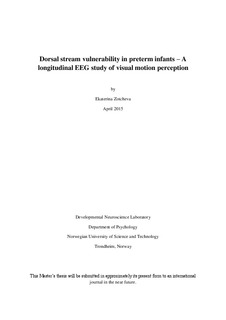| dc.description.abstract | High-density electroencephalogram (EEG) was used to longitudinally investigate evoked and induced brain electrical activity as a function of visual motion in full-term and preterm infants at 4-5 and 12 months of age. The infants were presented with two visual motion paradigms, optic flow and looming. The optic flow experiment simulated structured forwards and reversed optic flow and random visual motion, while the looming experiment simulated a looming object approaching on a direct collision course under three different accelerations. Analyses of visual evoked potentials (VEPs) and temporal spectral evolution (TSE) were performed on EEG data recorded with a 128-channel Geodesic Sensor Net 200 (GSN). VEP results for optic flow revealed a significant decrease in latencies for forwards and reversed optic flow, but not for random visual motion, in full-term infants with age. In addition, the 12-month-old full-term infants significantly differentiated between structured optic flow and random visual motion, with longest latencies for random visual motion, and shortest latencies for forwards optic flow. VEP results for looming revealed a significant decrease in time-to-collision of their looming-related VEP responses in the full-term infants with age. In addition, the 12-month-old full-term infants responded at a fixed time-to-collision, irrespective of loom speed. The TSE analyses revealed an increase in late alpha and early beta band synchronization in the TSE maps of the visual motion conditions in full-term infants with age. Although some preterm infants showed a similar increase in higher-frequency synchronization with age, this increase was less prominent, and some preterm infants did not show an increase at all. In addition, the preterm infants did not show a significant decrease in VEP latencies for optic flow, did not significantly differentiate between structured optic flow and random visual motion, did not show a significant decrease in time-to-collision of their looming-related VEP responses, and did not show their looming-related VEP responses at a fixed time-to-collision at 12 months of age. It was suggested that the full-term infants’ progression in visual motion processing can be attributed to an increase in self-produced locomotor experience and accompanying neural maturation. The preterm infants’ poorer performance on the visual motion experiments can be related to a deficit in the processing of visual motion, a dorsal stream function. More follow-up research is needed to further investigate whether the dorsal stream impairment persists into later life, and to what extent this impairment may affect the everyday lives of individuals born prematurely. | nb_NO |
